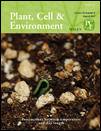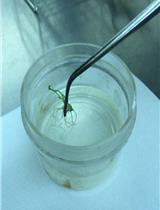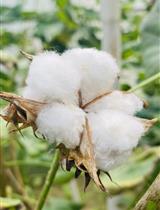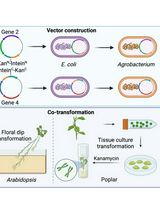- EN - English
- CN - 中文
Generation and Selection of Transgenic Olive Plants
转基因橄榄植物的产生与筛选
发布: 2017年11月20日第7卷第22期 DOI: 10.21769/BioProtoc.2611 浏览次数: 9498
评审: Scott A M McAdamMoritz BomerAnonymous reviewer(s)
Abstract
Olive (Olea europaea L.) is one of the most important oil crops in the Mediterranean basin. Biotechnological improvement of this species is hampered by the recalcitrant nature of olive tissue to regenerate in vitro. In previous investigations, our group has developed a reliable Agrobacterium-mediated transformation protocol using olive somatic embryos as explants (Torreblanca et al., 2010). Embryogenic cultures derived from radicles of matured zygotic embryos are infected with Agrobacterium tumefaciens, AGL1 strain, containing a binary plasmid with the gene of interest and the nptII selection gene. After a meticulous selection procedure, carried out using solid and liquid media supplemented with paromomycin, the putative transformed lines are established. A preliminary confirmation of their transgenic nature is carried out through PCR amplification. Afterwards, plants can be obtained through an efficient regeneration protocol, whose main characteristics are the use of a low-ionic-strength mineral formulation, a phase in liquid medium for synchronization of cultures and the use of semi-permeable cellulose acetate membranes for embryo maturation (Cerezo et al., 2011). Final confirmation of transgene insertion is carried out through Southern or Northern analysis using leaf samples of regenerated plants.
Keywords: Olea europaea (油橄榄)Background
The protocol developed by Torreblanca et al. (2010) differs from the previous olive transformation protocol, developed by Rugini et al. (2000), in several aspects; mainly, kind of explant, Agrobacterium strain and the selection method used. Rugini et al. (2000) used embryogenic masses as explants, which were incubated in a bacterial suspension of LBA4404 Agrobacterium strain for 48 h. After the infection, the explants were rinsed in water and cultured in embryogenic medium supplemented with 250 mg/L cefotaxime; however, the selection of transgenic embryos was not started until 30 days after the infection, with the addition of 100 mg/L kanamycin. To speed up the process, the explants were transferred to liquid medium in light, and the embryos which turned green were selected and cultured in isolation on solid multiplication medium with 150 mg/L kanamycin. Later on, the plant regeneration process was carried out without kanamycin. In contrast, Torreblanca et al. (2010) used globular somatic embryos as explants and the AGL1 Agrobacterium strain, with an incubation period of only 2 h and 2 days co-culture. Afterwards, the explants were transferred to selection medium with 200 mg/L paromomycin, and re-cultured onto fresh selection medium weekly during the first month and bi-weekly thereafter. In addition, a 3 weeks selection period in liquid medium supplemented with 50 mg/L paromomycin was included. The selection process and the use of somatic embryos as explants solved the problems of chimaeric transgenic embryos appearance, and higher transformation efficiencies were obtained. The protocol for olive plant regeneration published by Cerezo et al. (2011) improved whole plant recovery (shoots and roots) from 1.5% up to 50%. Both protocols together, have allowed the development of a reliable regeneration and transformation procedure in olive, recently used in flower induction studies (Haberman et al., 2017). Indeed, these protocols have been employed to analyze the effect of overexpression of MtFT1 gene in olive.
Materials and Reagents
- Biological material
- Embryogenic olive cultures, formed by callus and globular embryo structures of yellow-creamed colour
- Agrobacterium tumefaciens AGL1 strain harbouring a binary vector, containing the gene of interest and the nptII selection gene
- Embryogenic olive cultures, formed by callus and globular embryo structures of yellow-creamed colour
- Chemicals and materials
- Sterile filter paper cut 10 x 10 cm (Filtros Anois, FILTER-LAB®, catalog number: RM13054252 )
- Petri plates (90 cm) (J. D. CATALAN, S. L.)
- Mesh, 3 x 3 (ALBUS Suministros de Laboratorio)
- Active charcoal (Sigma-Aldrich, catalog number: C9157 )
- Assay tubes (25 x 150 mm) (Kimble Chase Life Science and Research Products, catalog number: 73500-20150 )
- Dialysis tubing cellulose membrane (Sigma-Aldrich, catalog number: D9777-100FT )
- Jiffystrips 5-50 peat pots square, 4.5 x 4.5 cm (Jiffy, catalog number: 110007 )
- Plant pots (12.5 and 20 cm)
- 1:1 peat moss:perlite substrate (Projar professional)
- Agrobacterium liquid growth medium (LB medium) (AppliChem, catalog number: 414753 )
- 10 mM magnesium sulphate (MgSO4) (AppliChem, catalog number: 131404 )
- Antibiotics:
- ¼ OM (Cañas and Benbadis, 1988) macroelements
- ¼ MS (Murashige and Skoog, 1962) microelements
- ½ OM Vitamins
- Myo-inositol (Sigma-Aldrich, catalog number: I5125 )
- Sucrose (D(+)-Saccharose) (VWR, catalog number: 27478.467 )
- L-Glutamine (Biowest, catalog number: P1012 )
- Casein hydrolysate (N-Z-Amine® A) (Sigma-Aldrich, catalog number: C0626 )
- Mannitol (Sigma-Aldrich, catalog number: M9647 )
- Plant hormones:
- Olive cyclic embryogenesis medium (ECO) (see Recipes)
- Germination medium (see Recipes)
- Shoot proliferation medium (see Recipes)
- Plant rooting medium (see Recipes)
- Sterile filter paper cut 10 x 10 cm (Filtros Anois, FILTER-LAB®, catalog number: RM13054252 )
Equipment
- Culture flasks (125 ml) (Nalgene)
- Autoclave (JP SELECTA, model: Autester MOD 437-G )
- Constant temperature/orbital shaker incubator (Optic Ivymen System)
- Laminar flow hood (Telstar, model: BH-100 )
- Laboratory centrifuge (Sigma Laborzentrifugen, model: 3K30 )
- Spectrophotometer (JP SELECTA, model: UV-2005 )
- Walk in plant growth cabinet with controlled light and temperature conditions
Procedure
文章信息
版权信息
© 2017 The Authors; exclusive licensee Bio-protocol LLC.
如何引用
Palomo-Ríos, E., Cerezo, S., Mercado, J. A. and Pliego-Alfaro, F. (2017). Generation and Selection of Transgenic Olive Plants. Bio-protocol 7(22): e2611. DOI: 10.21769/BioProtoc.2611.
分类
植物科学 > 植物转化 > 农杆菌介导的转化方法
分子生物学 > DNA > 转化
您对这篇实验方法有问题吗?
在此处发布您的问题,我们将邀请本文作者来回答。同时,我们会将您的问题发布到Bio-protocol Exchange,以便寻求社区成员的帮助。
提问指南
+ 问题描述
写下详细的问题描述,包括所有有助于他人回答您问题的信息(例如实验过程、条件和相关图像等)。
Share
Bluesky
X
Copy link












